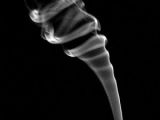More than 70 years ago a simple experiment was performed involving water passing through a pipe. The result has baffled scientists ever since, but now the mystery has finally been solved. The solution also sheds new light on the more general mystery of turbulence - the last major unsolved problem in classical physics.
One anecdote about Heisenberg it's that he once said he wanted to ask God two questions. One was 'why is general relativity so weird?' and the other one was 'how do you explain turbulence?'. He then said that he was certain God would know the answer to the first question. As a student, Heisenberg was asked by one of his teachers to pursue the unsolved problem of turbulence. He refused saying it was much too difficult and focused instead on fundamental physics and became one of the creators of quantum mechanics. In his later years he returned to the problem of turbulence but never solved it.
In 1933, Johann Nikuradse carefully measured the friction experienced by a fluid as it is forced through a pipe at varying speeds. Nikuradse found that the friction gets smaller as the speed gets larger, but then, to everybody's surprise, at even higher speeds it increases again before attaining a constant value. This mysterious behavior, which must be taken into account by engineers in applications ranging from airplanes to oil pipelines, has now been explained by scientists at the University of Illinois at Urbana-Champaign.
This behavior is one of many aspects of turbulence.
"Turbulence is the jittery, swirling behavior of a gas or liquid when flowing next to a wall or around an obstacle," said Gustavo Gioia, a professor of theoretical and applied mechanics at Illinois. "Although most of the flows that surround us in everyday life are turbulent flows over rough walls, these flows have remained one of the least understood phenomena of classical physics."
The point about turbulence is that it is in fact a self-organized motion. It isn't random. Tranquil water is in fact more random because in there molecules go around at random without being correlated with each other over large distances. So: Why do eddies appear when water flows by an obstacle? It's hard to tell. The general idea is that there should be something which gets minimized (or maximized) - eddies are in some sense the most "efficient" way water can flow in the given conditions. Thus, water molecules correlate their motions in order to form eddies. But what exactly is this "efficient"? No one really knows for sure.
Nonetheless, Gioia and graduate student Pinaki Chakraborty have managed to explain the phenomenon discovered by Nikuradse. They have shown how this strange behavior arises from the fundamental properties of the way in which energy is distributed among the swirling eddies that populate a turbulent flow. Thus, in order to understand the pipe flow phenomenon one needs to think about the eddies that appear at high speeds and about how they interact. It isn't sufficient to perceive the liquid as a homogenous mass that passes through the pipe.
"As a result of our theoretical explanation, engineers can now calculate the friction force found along rough walls, rather than rely upon a chart or table based on the Nikuradse data," Chakraborty said.
In a related work, to appear in the same issue of Physical Review Letters, Illinois physics professor Nigel Goldenfeld also shows that the turbulent state is indeed not random, but contains subtle statistical correlations similar to those known to exist at phase transitions, such as the onset of magnetism in crystals.
A metal becomes magnetic when clusters of atoms feel one another's magnetic forces and align their magnetic moments in the same direction, like a collection of tiny arrows all adding up to one big arrow. If you heat them up, the arrows jiggle more and more, and at very high temperatures, they all point in random directions. However, there is an intermediate, "Curie" temperature, where atoms can still feel one another's magnetism and form aligned clusters, although each cluster points in a random direction.
According to Goldenfeld's study, the formation of eddies might be a similar phenomenon. The rise of temperature in case of magnets is similar to the increase in velocity in case of the fluid passing through a pipe. Eddies are thus similar to the clusters of atoms.
"These findings suggest a new tack for theorists trying to understand turbulence," Goldenfeld said.
The researchers hope that as a result of these discoveries, the approaches that solved the problem of phase transitions will now find a new and unexpected application in providing a fundamental understanding of turbulence.
On the other hand, it seems that turbulence offers us at macroscopic level a view of what happens during other phase transitions at microscopic level. Thus, when you are looking at eddies in a river, at turbulence in a cascade or at cigarette smoke you can also imagine that you are actually watching what happens to molecules during a melting process or how magnetism gradually vanishes when a magnet is melted.
Photo credits: Clouds (NASA); "Tranquility and Turbulence" (Robert Barry); Cigarette smoke (Pal & Basu)

 14 DAY TRIAL //
14 DAY TRIAL // 

